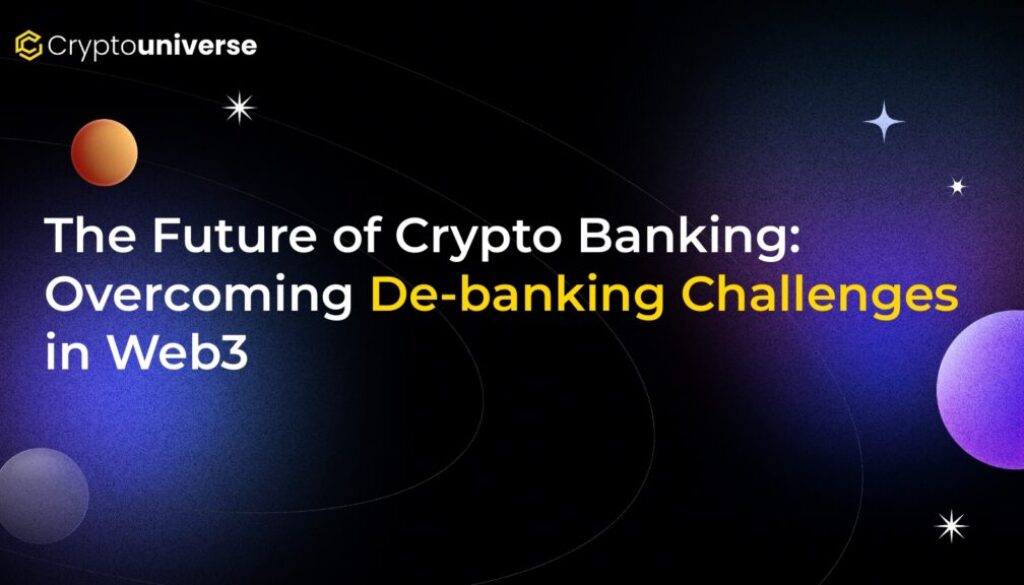The Future of Crypto Banking: Overcoming De-banking Challenges in Web3

The Unseen Wall: Why Crypto Innovators Are Getting Locked Out of Banking
Imagine building a revolutionary Web3 platform, only to be stopped by the most basic hurdle: opening a bank account. For countless crypto and digital asset companies, this isn’t a hypothetical scenario; it’s a frustrating reality. This phenomenon, known as “crypto de-banking,” has been a major roadblock, stifling innovation and pushing legitimate businesses to the financial fringes. But the tides may be turning.
A significant shift is underway, spearheaded by regulators who recognize that the financial system must evolve. Leading the charge is the U.S. Office of the Comptroller of the Currency (OCC), which is signaling a new, more inclusive era for digital finance. In this post, we’ll explore the core challenges of crypto de-banking, the regulatory changes paving a new path forward, and the future of an integrated financial landscape.
What Exactly is Crypto De-banking?
Crypto de-banking is when traditional financial institutions refuse to provide services to or terminate existing accounts for businesses operating in the cryptocurrency sector. This isn’t just about closing a checking account; it affects everything from payroll and vendor payments to securing capital, effectively cutting companies off from the mainstream financial system.
But why are banks so hesitant? The reasons are rooted in a mix of caution, confusion, and complexity:
- Regulatory Fog: For years, a lack of clear, consistent guidelines from regulators has left banks in a state of uncertainty. Fearing accidental non-compliance with complex anti-money laundering (AML) and know-your-customer (KYC) laws, many have opted to avoid the crypto space altogether.
- The Risk Perception: The crypto industry’s early association with illicit activities, combined with its inherent price volatility, has created a high-risk perception. Banks worry about potential involvement in financial crime and the reputational damage that could follow.
- Operational Headaches: Servicing crypto companies isn’t straightforward. It requires significant investment in new technology, specialized compliance teams, and expertise that most traditional banks don’t possess and are reluctant to build.
This widespread de-banking has forced innovative firms to seek banking partners in less-regulated jurisdictions or rely on complex workarounds, hindering their growth and the overall maturation of the Web3 ecosystem.
A New Dawn: How Regulators Are Tackling De-banking
The status quo is finally being challenged. Under the leadership of figures like Acting Comptroller Jonathan Gould, the OCC is taking a proactive stance to dismantle these barriers. This isn’t just talk; it’s a strategic move to foster financial innovation within a secure framework.
Two key initiatives are at the forefront of this change:
- Removing Outdated Rules: The OCC has proposed eliminating restrictive, anti-crypto licensing requirements that have historically made it difficult for digital asset firms to gain a foothold. This move signals a fundamental shift from a posture of skepticism to one of regulated inclusion.
- Prioritizing Stablecoin Clarity: Perhaps the most critical development is the focus on establishing clear regulations for stablecoins. Stablecoins act as a vital bridge between the crypto and fiat worlds. By creating a clear rulebook for their issuance and use, regulators can give banks the confidence and legal certainty they need to service stablecoin issuers and the broader crypto economy.
Bridging the Gap: The Impact on Crypto and Traditional Finance
This regulatory thaw has profound implications for both sides of the financial spectrum, creating a powerful win-win scenario.
For the Crypto Industry
For Web3 companies, access to stable, reliable banking is a game-changer. It means less time and resources spent searching for friendly banking partners and more time focused on building innovative products. This stability will unlock greater operational efficiency, attract more institutional investment, and accelerate mainstream adoption.
For Traditional Banks
For traditional banks, this is a golden opportunity to evolve and stay relevant. By embracing the digital asset economy, they can tap into new, lucrative revenue streams and attract a new generation of tech-savvy clients. Offering regulated, secure banking services to crypto firms allows them to diversify their portfolios and position themselves as forward-thinking leaders in a rapidly changing financial world.
The Future is Here: Innovative Crypto Banking Models
As the regulatory environment improves, a new generation of banking solutions is emerging to meet the unique needs of the crypto industry. These models are not just replacing old systems; they are building a more efficient and inclusive financial future.
- Bank-Led Crypto Services: We are seeing major banks move beyond apprehension and begin integrating crypto custody, trading, and other services directly into their offerings.
- Crypto-Native Neo-Banks: Digital-first banking platforms are being built from the ground up to serve the Web3 community, offering seamless integration between fiat and digital assets.
- Deeper Blockchain Integration: Traditional banks are starting to adopt blockchain technology themselves to improve the transparency, speed, and efficiency of transactions like cross-border payments.
- The Rise of Programmable Assets: The development of central bank digital currencies (CBDCs) and other tokenized assets will further reshape banking by enabling real-time, programmable transactions with lower costs and enhanced security.
Conclusion: A Brighter Future for Web3 Finance
The era of crypto de-banking is coming to an end. Thanks to the bold initiatives from regulators like the OCC, the walls between traditional finance and the digital asset economy are crumbling. By providing much-needed clarity, especially around stablecoins, we are paving the way for a more integrated, innovative, and supportive financial ecosystem.
The road ahead will have its challenges, but the direction is clear. The Future of Crypto Banking is not about replacing the old system but about building bridges to a better one. As this new landscape takes shape, having a partner that understands both worlds is essential. Platforms like OneSafe are designed for this new era, bringing your crypto and banking needs together in one simple, powerful platform.


